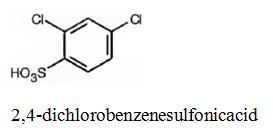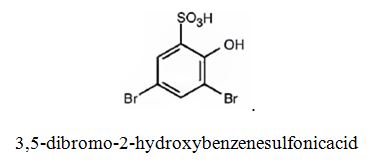
a)

Interpretation:
The major product(s) obtainable from sulfonation of fluorobenzene is/are to be predicted.
Concept introduction:
The substituents attached to the ring have a strong influence on the incoming electrophile. Electron releasing substituent groups, except halogens, activate the ring and direct the incoming electrophile to the o- and p- positions. Halogens are o- and p- directors but they deactivate the ring. Electron withdrawing substituent groups deactivate the ring and direct the incoming electrophile to the m- position.
To predict:
The major products obtainable from sulfonation of fluorobenzene.
Answer to Problem 51AP
The major products obtainable from sulfonation of fluorobenzene are o-flurobenzenesulfonic acid and p- flurobenzenesulfonic acid.

Explanation of Solution
Fluorine attached to an aromatic ring is an o- and p- directing deactivating group. Hence it directs the electrophile, SO3H+ to these positions.

The major products obtainable from sulfonation of fluorobenzene are o-flurobenzenesulfonic acid and p- flurobenzenesulfonic acid.

b)

Interpretation:
The major product(s) obtainable from sulfonation of m-bromophenol is/are to be predicted.
Concept introduction:
Electrophilic substitution of disubstituted benzenes follows three simple rules. (i) If the directing influence of both the substituents reinforce each other, a single product results. (ii) If the directing influences of both the substituent groups oppose each other, the most powerful activating group among them has the dominant influence but usually a mixture of products results. (iii) In meta disubstituted compounds, further substitution in between the groups occurs only rarely, due to steric reasons.
To predict:
The major product(s) obtainable from sulfonation of m-bromophenol.
Answer to Problem 51AP
The major products produced during the sulfonation of m-bromophenol are 2-bromo-4-hydroxybenzenesulfonicacid (I) and 4-bromo-2-hydroxybenzenesulfonicacid (II).

Explanation of Solution
The Br is an ortho and para directing and deactivating group while -OH group is also an ortho and para directing and highly activating group. Hence the -OH group decides the position at which the electrophilic substitution reaction will occur. The electrophile, SO3H+, enters into the ortho and para positions with respect to -OH group to produce 2-bromo-4-hydroxybenzenesulfonicacid (I) and 4-bromo-2-hydroxybenzenesulfonicacid (II).

The major products produced during the sulfonation of m-bromophenol are 2-bromo-4-hydroxybenzenesulfonicacid (I) and 4-bromo-2-hydroxybenzenesulfonicacid (II).

c)

Interpretation:
The major product(s) obtainable from sulfonation of m-dichlorobenzene is/are to be predicted.
Concept introduction:
Electrophilic substitution of disubstituted benzenes follows three simple rules. (i) If the directing influence of both the substituents reinforce each other, a single product results. (ii) If the directing influences of both the substituent groups oppose each other, the most powerful activating group among them has the dominant influence but usually a mixture of products results. (iii) In meta disubstituted compounds, further substitution in between the groups occurs only rarely, due to steric reasons.
To predict:
The major product(s) obtainable from sulfonation of m-dichlorobenzene.
Answer to Problem 51AP
The major product produced during the sulfonation of m-dichlorobenzene is 2,4-dichlorobenzenesulfonicacid.

Explanation of Solution
In electrophilic substitution reactions, Cl is an ortho and para directing and deactivating group. Hence the electrophile, SO3H+, can enter into the ortho and para positions with respect to both Cl atoms. The ortho position in between the two Cl atoms is not favored for steric reasons. Hence the SO3H gets substituted in the p-position to a Cl which happens to be the ortho position to another Cl to yield 2,4-dichlorobenzenesulfonicacid.

The major product produced during the sulfonation of m-dichlorobenzene is 2,4-dichlorobenzenesulfonicacid(I).

d)

Interpretation:
The major product(s) obtainable from sulfonation of 2,4-dibromophenol is/are to be predicted.
Concept introduction:
Electrophilic substitution of di and trisubstituted benzenes follows three simple rules. (i) If the directing influence of both the substituents reinforce each other, a single product results. (ii) If the directing influences of both the substituent groups oppose each other, the most powerful activating group among them has the dominant influence but usually a mixture of products results. (iii) In meta disubstituted compounds, further substitution in between the groups occurs only rarely, due to steric reasons.
To predict:
The major product(s) obtainable from sulfonation of 2,4-dibromophenol.
Answer to Problem 51AP
The major product produced during the sulfonation of 2,4-dibromophenol is 3,5-dibromo-2-hydroxybenzenesulfonicacid.

Explanation of Solution
In aromatic electrophilic substitution reactions Br is an ortho and para directing and deactivating group while –OH group also though ortho and para directing is a highly activating group. Hence the –OH group decides the position at which the electrophilic substitution reaction will occur. The electrophile, SO3H+, enters into the ortho and para positions with respect to –OH group. The para position and one ortho position to –OH are blocked by substituents. Hence the SO3H+ enters into the another ortho position to –OH group available to produce 3,5-dibromo-2-hydroxybenzenesulfonicacid.

The major product produced during the sulfonation of 2,4-dibromophenol is 3,5-dibromo-2-hydroxybenzenesulfonicacid.

Want to see more full solutions like this?
Chapter 16 Solutions
ORGANIC CHEMISTRY W/OWL
- Can you explain how I get these here and show the steps plz?arrow_forwardGive the IUPAC name for this compound Hydrocarbon Condensed Formulas Hint C2H5 CH2CH3 expand that in all the formula Part A: (CH3)2CHCH(C2H5)CH2CH2CH3 Give the IUPAC name for this compound. Part B: CH2=C(C2H5)CH2CH2CH3 Give the IUPAC name for this compound. Part C: (CH3)2C=CHC(C2H5)=CH2 Give the IUPAC name for this compound. Part D: CH3C=CCH(C2H5)2 Give the IUPAC name for this compound. Part E: (CH3)3CC=CCH2CH=C(CH3)2arrow_forwardSelect/ Match the correct letter from the image below for the IUPAC names given below: A B C D 3 E F G H K L Part 1. 4-methylheptane For example.mmmm Answer Letter H _for part 1 Part 2. 2,4-dimethylhexane Part 3. 2,3-dimethylpentane Part 4. 2,2-dimethylhexane Part 5. 2-ethyl-1,1,3,3-tetramethylcyclopentane Part 6. 3-ethyl-2-methylpentanearrow_forward
- Can u show the process as to how to get these?arrow_forwardSketch the expected 'H NMR spectra for the following compound. Label all of the H's in the structure and the corresponding signal for the spectra you sketch. Make sure you include the integration value and the splitting pattern for each signal Indicate how many signals you would expect in the 13C NMRarrow_forwardUse IUPAC naming rules to name the following hydrocarbon compounds: CH2-CH3 | a) CH-CH-CH2-CH-CH-CH3 b) | CH2 CH3 | CH3 CH3 \ / C=C H 1 H CH2-CH3 c) d) CH=C-CH3 e) CH3-CH2-CH2-CH=CH-CH3 f) CH2=CH-CH2-CH=CH-CH3 g) CH3-CH2-C = C-CH2-CH3 h)arrow_forward
- Q5 Name the following : a. b. C. d. e.arrow_forward25. Predict the major product of the following reaction. 1 equivalent of each of the starting materials was used. H₂C CH3 CH3 H3C H3C H3C. CH2 + H3C. heat CH3 CH H.C. CH3 H.C H.C CH3 CH CH3 CH3 A B C Earrow_forwardFind chemical structures based on the below information. a) Chemical formula C6H8O Compound is aromatic plus has two 1H NMR peaks that integrated for 3 each that are singlets (it could have more peaks in the 1H NMR b) Chemical Formula: C6H100 Compounds is conjugated 'H NMR has a signal that integrates for 6 and is a doublet IR spectra has a signal at 1730 cm-1arrow_forward
- Jaslev Propose a synthesis of the following starting from benzene and any other reagents and chemicals. No mechanisms are required. Indicate the condition for each step plus the major product for each step. More than two steps are required. Step 1 Step 2 مہد Brarrow_forwardPart C: The line formula for another branched alkane is shown below. i. In the IUPAC system what is the root or base name of this compound? ii. How many alkyl substituents are attached to the longest chain? iii. Give the IUPAC name for this compound.arrow_forwardPart D: Draw the Structural Formula for 4-ethyl-2-methylhexane Part E. Draw the Structural Formula for 1-chloro-3,3-diethylpentane (Chloro = Cl)arrow_forward
 ChemistryChemistryISBN:9781305957404Author:Steven S. Zumdahl, Susan A. Zumdahl, Donald J. DeCostePublisher:Cengage Learning
ChemistryChemistryISBN:9781305957404Author:Steven S. Zumdahl, Susan A. Zumdahl, Donald J. DeCostePublisher:Cengage Learning ChemistryChemistryISBN:9781259911156Author:Raymond Chang Dr., Jason Overby ProfessorPublisher:McGraw-Hill Education
ChemistryChemistryISBN:9781259911156Author:Raymond Chang Dr., Jason Overby ProfessorPublisher:McGraw-Hill Education Principles of Instrumental AnalysisChemistryISBN:9781305577213Author:Douglas A. Skoog, F. James Holler, Stanley R. CrouchPublisher:Cengage Learning
Principles of Instrumental AnalysisChemistryISBN:9781305577213Author:Douglas A. Skoog, F. James Holler, Stanley R. CrouchPublisher:Cengage Learning Organic ChemistryChemistryISBN:9780078021558Author:Janice Gorzynski Smith Dr.Publisher:McGraw-Hill Education
Organic ChemistryChemistryISBN:9780078021558Author:Janice Gorzynski Smith Dr.Publisher:McGraw-Hill Education Chemistry: Principles and ReactionsChemistryISBN:9781305079373Author:William L. Masterton, Cecile N. HurleyPublisher:Cengage Learning
Chemistry: Principles and ReactionsChemistryISBN:9781305079373Author:William L. Masterton, Cecile N. HurleyPublisher:Cengage Learning Elementary Principles of Chemical Processes, Bind...ChemistryISBN:9781118431221Author:Richard M. Felder, Ronald W. Rousseau, Lisa G. BullardPublisher:WILEY
Elementary Principles of Chemical Processes, Bind...ChemistryISBN:9781118431221Author:Richard M. Felder, Ronald W. Rousseau, Lisa G. BullardPublisher:WILEY





